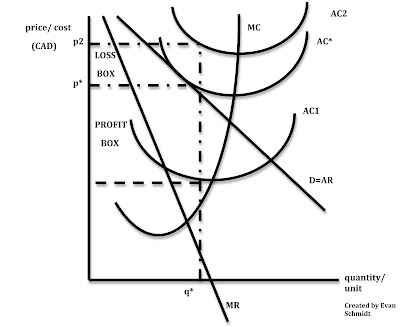Assumptions of the model -
- Many relatively small firms vis-a-vis the industry.
- Near perfect knowledge of product, prices and costs of production.
- Differentiated products : Making products (slightly or significantly) different from one another to attract different segments of the market and different customer loyalty levels (i.e. different types of cheese pizzas at restaurants in Rome)
- Low barriers to entry or exit.
In the short-run, abnormal profits and losses can be earned at the profit-maximizing level of output, MC=MR. In the long-run, like perfect competition (and very UNLIKE monopoly), only normal profits can be earned. If the AC curve is below the AR line, then there will be abnormal profits for monopoly and firms in monopolistic competition. If the AC curve is above the AR line, then there will be abnormal profits for monopolies and firms in monopolistic competition.

This graph looks identical to the monopoly graph because it is. However, in the long run, profits always return to normal from abnormal or loss. In the SR, if firms are making abnormal profits, over time, firms with enter the market to capture some of these profits because barriers to entry are low. When this occurs, the demand for each individual firm (which this graph shows) shifts in, and this will continue until MC=MR=AC and normal profits are achieved. If firms are making losses, the reverse will happen. Firms will start leaving the industry, demand will shift out until normal profits are achieved.
Firms that are monopolistically competitive are never efficient. But is this bad? Not necessarily! These efficiencies stem from the fact consumers get to choose between differentiated products. Therefore, it can be easily and logically argued that the disadvantages of not being efficient are made up by the advantages of choice. Can you imagine if all cheese pizzas tasted the same?
No comments:
Post a Comment